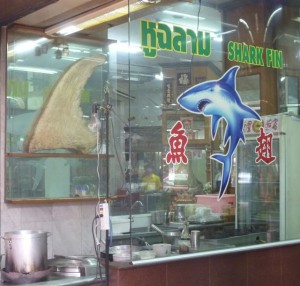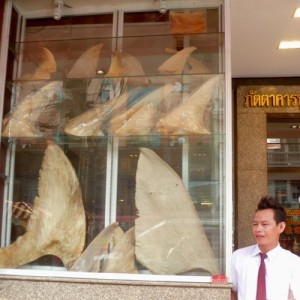Convention on International Trade in Endangered Species of Wild Fauna and Flora
CITES 2013 – Bangkok, 17:00 (local time)
Press Release No. 5
Of the 35,000 plant and animal species listed in the CITES* Appendices, only 15 fish will appear in Appendix I and 81 in Appendix II. Fisheries are strategic and political. They must feed humanity while also considering the oceanic territorial claims. Unfortunately, the bluefin tuna has disappeared from all monitors in Bangkok. By contrast, sharks are fighting back with force, accompanied by manta rays.
Where have the sharks gone?
Bangkok March 9, 2013. CN Photo / Robin des Bois.
The porbeagle (Lamna nasus): the proposed listing in Appendix II by the European Union, Brazil, the Comoros and Croatia was accepted with 93 votes in favor, 39 against and 8 abstentions – 2/3 of the votes needed. The vote was held by secret ballot at the request of Guinea. Populations of the northeast Atlantic and especially the Mediterranean are in critical danger of extinction. Since 2010, fishing of the porbeagle is prohibited in the waters of the European Union. Unfortunately the ban has produced adverse consequences: in 2010 and 2011, the EU imported more than 50 tons of porbeagle meat, a value of 128,000 euros. The porbeagle is one of six species on the global shark fin market. The proposed listing of the porbeagle in Appendix II was rejected in 2007 in The Hague, Netherlands, as well as in 2010 in Doha, Qatar by a few votes. Greenland-Denmark has already announced that it would enter a reservation if the decision is finally ratified by the plenary session next Wednesday or Thursday.
The oceanic whitetip shark (Carcharhinus longimanus): the proposed listing in Appendix II by Brazil, Colombia and the United States was accepted (92 votes in favor, 42 against and 8 abstentions). The vote was held by secret ballot at the request of China. Like many other species, oceanic sharks are caught “unintentionally” by high seas tuna and swordfish fisheries. The meat is not sold; rather, the fin is amputated before the shark is thrown overboard, still alive but crippled. The fins are sold for 35 to 75 euros per kg. This proposal was rejected in 2010.
The scalloped hammerhead shark (Sphyrna lewini), the great hammerhead shark (Sphyrna mokarran) and the smooth hammerhead shark (Sphyrna zygaena): the proposed listing in Appendix II by Brazil, Colombia, Costa Rica, the European Union, Ecuador, Honduras and Mexico was accepted (91 votes in favor, 39 votes against, 8 abstentions). The vote was held by secret ballot at the request of China. Juveniles frequent degraded coastal ecosystems. Sharks at the top of the marine food chain are contaminated with PCBs. Hammerhead sharks are caught “unintentionally” by gillnets and bottom-lines. A study of by-catch rates by the European industrial freezer trawlers targeting small pelagic fish off the coast of Mauritania has shown that hammerhead sharks accounted for 42% of the catch. On the Chinese market, unprocessed fins of “Gu Pian” sell for 100 euros/kg. At Doha in 2010, this proposal was rejected.
The listing of five shark species in Appendix II of CITES is positive. Many national regulations and relevant Regional Fisheries Management Organizations (RFMOs) prohibit shark finning, the disembarkment of vulnerable shark species, or their shipment aboard other vessels. They also recommend releasing the sharks back to sea after fishing. 70 to 80% of sharks are alive when they are released. Dual control by CITES and RFMOs will strengthen the enforcement of regulations or prior recommendations. These proposals were supported by Food and Agriculture Organization of the United Nations (FAO). The main opponents were consumer countries such as China, Thailand, Korea, Japan and Singapore.
Manta rays (Manta spp): the proposed listing in Appendix II by Brazil, Colombia and Ecuador has been accepted by 96 votes in favor, 23 against and 7 abstentions (secret ballot at the request of Cambodia). Thailand supported this proposal. Manta rays can measure up to 7m in wingspan. Populations are highly fragmented. Growth is very slow. They reach sexual maturity at 10 or 15 years of age. The gestation period is 10 to 14 months long. They give birth every 2-3 years. They are fished for their gill plates, which are used in Asian pharmacopoeia. This market is estimated at 3.8 million euros/year. Wholesalers earn a lot of profit, while the fishermen earn very little. Direct revenues from dive tourism to observe manta rays already reach 58 million euros around the world.
_____________________________
*Convention on International Trade in Endangered Species of Wild Fauna and Flora.
 Imprimer cet article
Imprimer cet article











